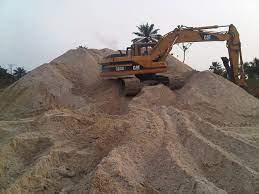
Dredging plays a crucial role in shaping the landscape and infrastructure of coastal regions. In Nigeria, a country blessed with an extensive network of rivers and a vast coastline, dredging has emerged as a vital activity for economic development, trade facilitation, and environmental management.
Dredging involves the excavation and removal of sediments, silt, and debris from water bodies, typically rivers, lakes, and coastal areas, to deepen or maintain navigational channels. In Nigeria, dredging is primarily conducted to improve access to ports, facilitate inland navigation, and extract sand for construction purposes.
Economic Significance of Dredging in Nigeria
Port Development and Trade Facilitation - Dredging plays a critical role in developing and expanding port infrastructure in Nigeria. Ports are vital gateways for international trade, and efficient dredging operations ensure that vessels can access harbors safely and smoothly.
The deepening of channels allows for larger ships to dock, thereby attracting more maritime traffic, increasing cargo volumes, and bolstering trade activities.
Inland Waterways Development - Nigeria boasts a vast network of inland waterways, including the Niger and Benue rivers, which provide an alternative mode of transportation for goods and people.
Dredging ensures the maintenance and navigability of these waterways, enabling the movement of goods across different regions and reducing pressure on road transportation. This development contributes to the economic growth of remote areas and encourages interconnectivity within the country.
Sand Extraction and Construction - Dredging activities also focus on extracting sand from riverbeds and coastal areas. The extracted sand serves as a crucial raw material in the construction industry, supporting infrastructure development, housing projects, and urban expansion. Dredging companies contribute to the supply chain of the construction sector, creating employment opportunities and boosting the economy.
Nigeria, with its vast coastline and numerous rivers, offers significant opportunities for sand dredging businesses. The construction industry, rapid urbanization, and infrastructure development create a constant demand for sand, making it an attractive venture for aspiring entrepreneurs. However, starting a sand dredging business requires careful planning, adherence to legal regulations, and effective operational strategies.
This article aims to provide a comprehensive guide on how to start a sand dredging business in Nigeria.
Conduct Market Research
Before diving into the sand dredging industry, it is essential to conduct thorough market research. Identify the demand for sand in your target area, understand the competition, and analyze potential customers. Explore the local construction industry, infrastructure projects, and government initiatives that might drive the demand for sand. This research will help you assess the viability of your business and make informed decisions.
Understand Legal and Regulatory Framework
Operating a sand dredging business in Nigeria requires compliance with legal and regulatory requirements. Familiarize yourself with the laws governing the industry, including environmental regulations, permits, and licenses. Contact the relevant government agencies such as the Ministry of Mines and Steel Development, National Inland Waterways Authority (NIWA), and the Department of Petroleum Resources (DPR) to gather information and obtain necessary approvals.
Develop a Business Plan
A well-structured business plan is crucial for the success of any venture. Outline your vision, mission, and objectives for the sand dredging business. Include a detailed analysis of the market, competition, and potential customers. Develop a marketing strategy, operational plan, and financial projections. Your business plan will serve as a roadmap, helping you stay focused and make informed decisions throughout the journey.
Secure Funding
Starting a sand dredging business requires a substantial investment in equipment, manpower, and operational costs. Evaluate your financial resources and explore various funding options. This may include personal savings, loans from financial institutions, partnerships, or seeking investors. Prepare a comprehensive budget that includes expenses for acquiring dredgers, hiring personnel, maintenance, fuel, permits, and marketing.
Acquire Dredging Equipment
The core of your sand dredging business lies in acquiring the right equipment. Dredgers are available in various sizes and specifications.
Some dredgers and their specification are listed below
Cutter Suction Dredger: Cutter Suction Dredgers (CSDs) are one of the most commonly used types of dredgers. These versatile vessels are equipped with a rotating cutter head at the suction inlet, which cuts and loosens the sediment. The suction pipe, connected to a pump, then lifts the material into the dredger. CSDs are effective in excavating a wide range of materials, from soft silt to compacted sand. They are often used for deepening channels, harbor maintenance, land reclamation, and creating new waterways.
Trailing Suction Hopper Dredger: Trailing Suction Hopper Dredgers (TSHDs) are self-propelled vessels that operate by trailing a suction pipe over the seabed. The dredged material is sucked into the hopper through the pipe using powerful pumps. Once filled, the vessel sails to a designated disposal site and releases the material through bottom doors or pumping mechanisms. TSHDs are highly efficient in dredging loose, unconsolidated materials such as sand, silt, and gravel. They are commonly used for beach nourishment, maintenance dredging, and land reclamation.
Bucket Wheel Dredger: Bucket Wheel Dredgers feature a large wheel with multiple buckets attached to its rim. As the wheel rotates, the buckets scoop up the sediment and transport it to a discharge point. These dredgers are particularly effective in excavating cohesive and hard soils, such as clay and rock. Bucket Wheel Dredgers are commonly used in mining operations, harbor deepening projects, and inland waterways where a high production rate is required.
Backhoe Dredger: Backhoe Dredgers are versatile excavators mounted on a barge or pontoon. They feature a large hydraulic arm, similar to a backhoe, fitted with a bucket or grab. Backhoe dredgers are capable of dredging a wide variety of materials, including rock, clay, and sand. They are widely used in port construction, waterway maintenance, and environmental remediation projects. Backhoe dredgers offer excellent maneuverability and flexibility in shallow waters and confined spaces.
Grab Dredger: Grab Dredgers, also known as Clamshell Dredgers, employ a bucket or grab suspended from a crane to excavate material. The grab is lowered into the water, opened, and closed around the material to be dredged. Once filled, it is lifted and transported to the designated disposal area. Grab dredgers are effective in handling cohesive materials and debris. They are commonly used for dredging contaminated sediments, harbor clean-up operations, and maintenance dredging.
Water Injection Dredger: Water Injection Dredgers utilize the force of high-pressure water jets to loosen and transport sediment. These dredgers are equipped with powerful pumps that eject water under high pressure, creating a slurry and entraining the material. The slurry is then transported through pipelines to a separation or disposal area. Water Injection Dredgers are often employed for land reclamation, environmental remediation, and precision dredging in sensitive areas.
Consider the depth of the water bodies in your area and the estimated volume of sand extraction to determine the appropriate dredger type. Purchase or lease high-quality dredgers from reliable suppliers or consider importing if suitable options are not available locally.
Hire Qualified Personnel
To ensure the efficient operation of your sand dredging business, hire qualified personnel with relevant experience in dredging operations. This includes skilled dredge operators, maintenance technicians, engineers, and administrative staff. Invest in their training and provide a safe working environment to maximize productivity and minimize operational risks.
Establish Supply Chain and Partnerships
Develop a strong supply chain by establishing partnerships with suppliers and transporters. Identify reliable sources of sand and negotiate favorable contracts. Collaborate with transportation companies to ensure a smooth flow of sand from the extraction site to the customers. Building strong relationships within the industry will help you secure steady supplies and timely deliveries.
Implement Environmental Sustainability Measures
Sand dredging, if not managed responsibly, can have adverse environmental impacts. Take proactive measures to minimize these effects and demonstrate your commitment to environmental sustainability. Ensure compliance with environmental regulations, implement proper waste management practices, and restore the dredged areas to their original condition. This approach will not only protect the environment but also enhance your business reputation.
Market and Promote Your Business
Develop a comprehensive marketing strategy to create awareness and attract customers. Establish a strong online presence through a professional website and active social media channels. Network with construction companies, architects, and engineers to build relationships and secure contracts. Attend industry conferences and trade shows to showcase your services and establish credibility in the market.
Monitor Performance and Adapt
Once your sand dredging business is up and running, monitor its performance regularly. Keep track of key performance indicators (KPIs), such as revenue, profit margins, customer satisfaction, and operational efficiency. Analyze the data, identify areas for improvement, and adapt your strategies accordingly. Stay updated with industry trends and technological advancements to remain competitive and seize new opportunities.
Conclusion
Starting a sand dredging business in Nigeria requires careful planning, adherence to legal requirements, and strategic execution. By conducting market research, understanding the regulatory framework, developing a business plan, acquiring the right equipment, and implementing sustainable practices, you can position your business for success.
Remember to continuously evaluate your performance, adapt to market changes, and provide exceptional service to your customers. With dedication, perseverance, and a customer-centric approach, your sand dredging business can thrive in Nigeria's construction and infrastructure development landscape.






















